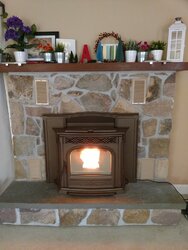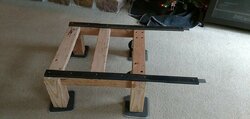I'm a new owner of a 52i with OAK fired up yesterday for the first time. Just out of curiosity, has anyone seen this bronze color stove before? I have been unable to find any reference to it on the Harman website. I bought the stove as a showroom sample and was told it was a special order color... not sure... Either way, I like the look much better than the enamel. I've also included a picture of the service rails I built.
Regarding pellet consumption. When people say they burn "1 bag a day" or "2 bags a day" do they generally refer to a full 24 hour day? Or starting up the stove in the morning and letting it burn itself out during the night?
Yesterday I filled the hopper with a 40lb bag and the stove ran for just under 15 hours before running out of pellets. I've read the sticky thread on how the stove works so I was playing around with the settings quite a bit but it seemed to be running the feed motor pretty frequently. For the overnight I left the stove in Room temp Manual with a setting of around 60-65 degrees. My temp sensor is probably in a bad spot since it seemed to keep running at a steady state even when the room temp was 72. I also tried Stove Temp Manual for several hours and turned the stove temp all the way down but it seemed to feed pellets pretty frequently. My burning pellets never got close to the edge and were burning pretty far back in the burn pot (maybe 2.5-3" from the lip) Oh, I left my feed limit knob set to about 3 the entire time.
Is this normal? I will try to do a more consistent test once the weather cools off again and I can run a full bag at the same Stove Temp Auto setting.
Oh... and how does well does the stove shut itself down in different settings? Since I knew I would run out of pellets some time during the night I made sure to leave my stove in Room Temp Manual mode so it would not try to run the igniter for 30+ minutes before giving up. Does Stove Temp Auto try to re-light after running out of pellets?
Thanks!
-Matt
Regarding pellet consumption. When people say they burn "1 bag a day" or "2 bags a day" do they generally refer to a full 24 hour day? Or starting up the stove in the morning and letting it burn itself out during the night?
Yesterday I filled the hopper with a 40lb bag and the stove ran for just under 15 hours before running out of pellets. I've read the sticky thread on how the stove works so I was playing around with the settings quite a bit but it seemed to be running the feed motor pretty frequently. For the overnight I left the stove in Room temp Manual with a setting of around 60-65 degrees. My temp sensor is probably in a bad spot since it seemed to keep running at a steady state even when the room temp was 72. I also tried Stove Temp Manual for several hours and turned the stove temp all the way down but it seemed to feed pellets pretty frequently. My burning pellets never got close to the edge and were burning pretty far back in the burn pot (maybe 2.5-3" from the lip) Oh, I left my feed limit knob set to about 3 the entire time.
Is this normal? I will try to do a more consistent test once the weather cools off again and I can run a full bag at the same Stove Temp Auto setting.
Oh... and how does well does the stove shut itself down in different settings? Since I knew I would run out of pellets some time during the night I made sure to leave my stove in Room Temp Manual mode so it would not try to run the igniter for 30+ minutes before giving up. Does Stove Temp Auto try to re-light after running out of pellets?
Thanks!
-Matt




